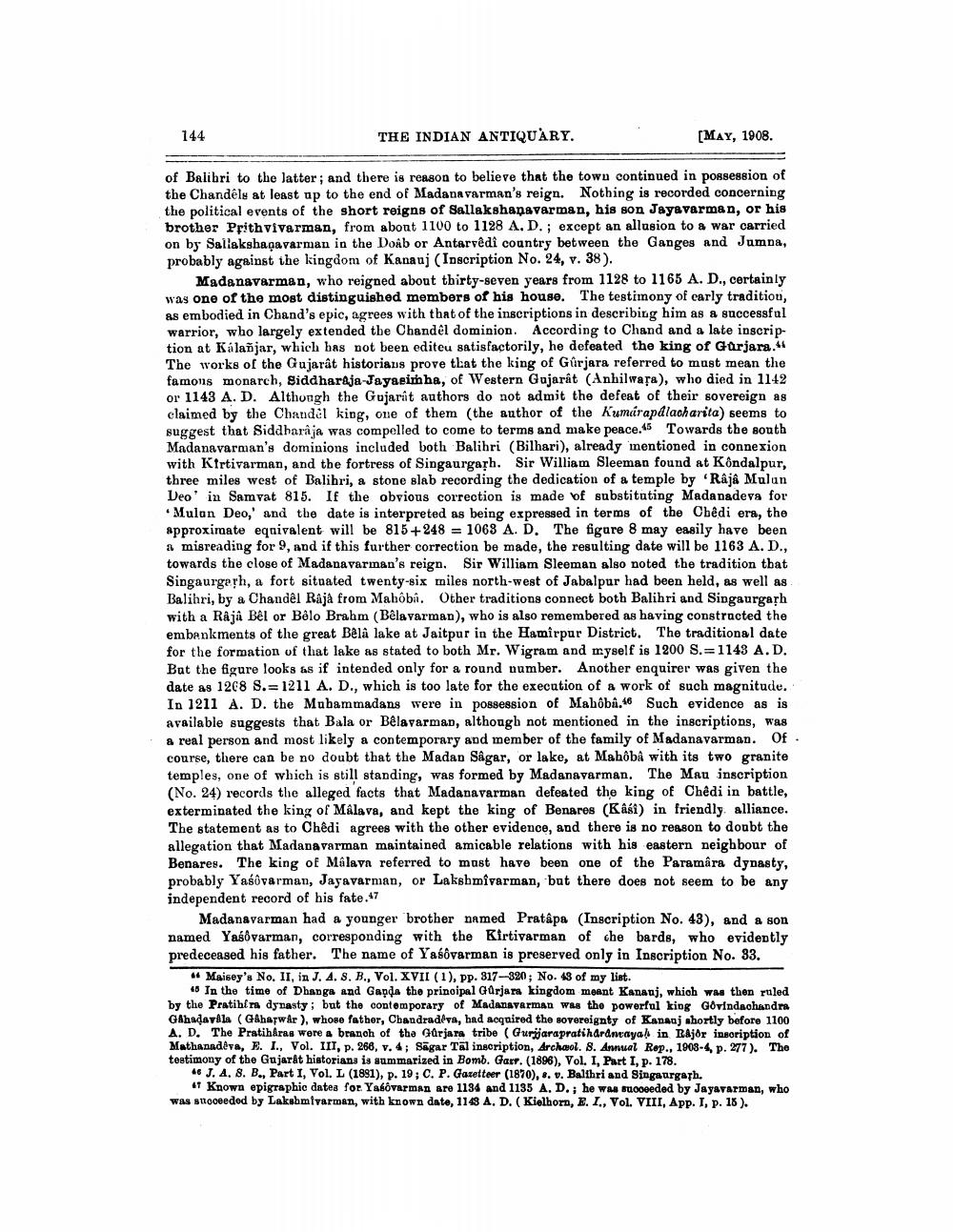________________
144
THE INDIAN ANTIQUARY.
[MAY, 1908.
of Balibri to the latter; and there is reason to believe that the town continued in possession of the Chandel, at least up to the end of Madanavarman's reign. Nothing is recorded concerning the political events of the short reigns of Sallakshanavarman, his son Jayavarman, or his brother Prithvivarman, from about 1100 to 1128 A.D.; except an allusion to a war carried on by Sallakshagavarman in the Doab or Antarvêdî country between the Ganges and Jumpa, probably against the kingdom of Kanauj (Inscription No. 24, v. 38).
Madanavarman, who reigned about thirty-seven years from 1128 to 1165 A. D., certainly was one of the most distinguished members of his house. The testimony of early traditiou, as embodied in Chand's epic, agrees with that of the inscriptions in describing him as a successful warrior, who largely extended the Chandel dominion. According to Chand and a late inscription at Kalaõjar, which has not been editeu satisfactorily, he defeated the king of Gurjara. The works of the Gujarat historiaus prove that the king of Gurjara referred to must mean the famous monarch, Siddharaja-Jayaeinha, of Western Gujarat (Anhilwara), who died in 1142 or 1143 A. D. Althongh the Gujarat authors do not admit the defeat of their sovereign as claimed by the Chandal king, one of them (the author of the humarapdlacharita) seems to suggest that Siddharaja was compelled to come to terms and make peace. Towards the south Madanavarman's dominions included both Balihri (Bilhari), already mentioned in connexion with Kirtivarman, and the fortress of Singaurgarh. Sir William Sleeman found at Kôndalpur, three miles west of Balibri, a stone slab recording the dedication of a temple by Râjâ Mulun Deo in Samvat 815. If the obvious correction is made of substitating Mada nadeva for • Mulan Deo,' and the date is interpreted as being expressed in terms of the Cbêdi era, the approximate equivalent will be 815 +248 = 1063 A. D. The figure 8 may easily have been a misreading for 9, and if this further correction be made, the resulting date will be 1163 A. D., towards the close of Madanavarman's reign, Sir William Sleeman also noted the tradition that Singaurgerh, a fort situated twenty-six miles north-west of Jabalpur had been held, as well as Balibri, by a Chandel Rajà from Mahoba. Other traditions connect both Balihri and Singaurgarh with a Râjâ Bel or Bêlo Brahm (Bêla varman), who is also remembered as having constructed the embankments of the great Bela lake at Jaitpur in the Hamirpur District. The traditional date for the formation of that lake as stated to both Mr. Wigram and myself is 1200 S.= 1143 A.D. But the figure looks as if intended only for a round number. Another enquirer was given the date as 1268 S.= 1211 A. D., which is too late for the execution of a work of such magnitude. In 1211 A. D. the Muhammadans were in possession of Mahoba.46 Such evidence as is available suggests that Bala or Bêlavarman, although not mentioned in the inscriptions, was a real person and most likely a contemporary and member of the family of Madanavarman. Of. course, there can be no doubt that the Madan Sagar, or lake, at Mahôbê with its two granite temples, one of which is still standing, was formed by Madanavarman, The Mau inscription (No. 24) records the alleged facts that Madanavarman defeated the king of Chedi in battle, exterminated the king of MAlava, and kept the king of Benares (Kasi) in friendly alliance. The statement as to Chedi agrees with the other evidence, and there is no reason to doubt the allegation that Madanavarman maintained amicable relations with his eastern neighbour of Benares. The king of Malava referred to must have been one of the Paramara dynasty, probably Yaśðvarman, Jayavarman, or Lakshmivarman, but there does not seem to be any independent record of his fate.47
Madanavarman had a younger brother named Pratápa (Inscription No. 43), and a son named Yaśðvarman, corresponding with the Kirtivarman of che bards, who evidently predeceased his father. The name of Yaśôvarman is preserved only in Inscription No. 33.
# Maisey's No. II, in J. A. S. B., Vol. XVII (1), pp. 317-320; No. 43 of my list.
10 In the time of Dhanga and Gapda the principal Gorjara kingdom meant Kananj, which was then ruled by the Pratiblrs dynasty ; but the contemporary of Madanavarman was the powerful king Govindachandra GAhadaylla (Gaharwar ), whose father, Chandradeva, had acquired the sovereignty of Kanaaj shortly before 1100 A. D. The Pratih&ras were a branch of the Gurjara tribe (Gurjjarapratihdranayal in Rajor insoription of Mathanadeva, E.I., Vol. III, p. 268, v. 4; Sagar Tal inscription, Archaol. 8. Annual Rep., 1908-4, p. 277). The testimony of the Gujarat historians is summarized in Bomb. Garr. (1896), Vol. I, Part I, p. 178.
46 J. A. 8. B., Part I, Vol. L (1891), p. 19; C. P. Gazetteer (1870), $. v. Balthri and Singaurgath.
*T Known epigraphic dates for Yalovarman are 1134 and 1135 A. D.; he was succeeded by Jayavarman, who was stooeeded by Lakshmivarman, with known date, 1148 A, D. (Kielhorn, E.I., Vol. VIII, App. I, p. 18).




